While shock collars for dogs are a controversial gadget, these devices are very instrumental in training dogs to walk politely, reinforce basic commands, and prevent or correct undesirable behavior like barking, digging, destructive chewing, and jumping on furniture.
And if you are looking for the best dog training collar, you’ve landed on the right page!
In this article, you will find our top 5 picks for the best dog shock collars with remote controls. Learn the different types of dog training collars, the benefits of using them, and what features to look for when buying one. Plus, we’ll be giving you tips on how to use a dog training device to train your pup safely and effectively.
Without further ado, let’s jump straight to the 5 top-rated dog shock collars you can get today!
| Editor's Choice | Product | Correction Mode | Stimulation Levels | Range | Collars Supported |
|---|---|---|---|---|---|
| Our Top Pick | DOG CARE Dog Training Collar | Tone, Vibration, Shock | 99 | 330 yards | 9 |
| Best For Large Dogs | SportDOG Brand 425X Remote Trainers | Tone, Vibration, Shock | 21 | 500 yards | 3 |
| Best For Small Dogs | Educator E-Collar ET-300 | Tone, Tapping Sensation | 100, with additional boost stimulus from 1 - 60 | 880 or 1320 yards | 1 |
| Best For Stubborn Dogs | Dogtra 1900S Remote Training Collar | Vibration, Shock | 127 | 1320 yards | 2 |
| Best for Budget | TBI Pro Dog Training Collar | Tone, Vibration, Shock | 1 - 100 | ~530 yards | 2 |
** Best Dog Training Collars Comparison
1. Our Top Pick - DOG CARE Dog Training Collar
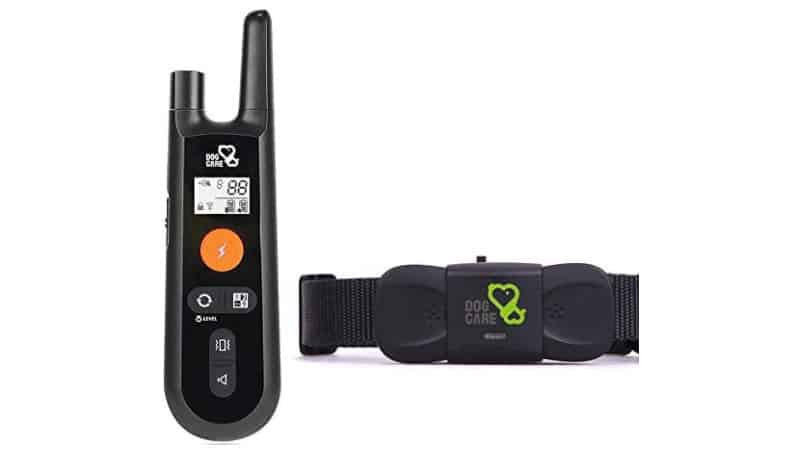
The DOG CARE Dog Training Collar is one of the most popular options on the market, featuring three safe modes, beep, vibration, and shock to train your dog.
It uses a unique technology that supports robust signals for multiple environments, designed with low voltage to ensure the electric pulses won’t hurt your furry friend. And what makes it stand out from the rest is that it gives you the ability to fine-tune intensity levels from 0 to 99 to match your dog’s temperament and behavior.
Not to mention, it can support up to nine receivers at a time and has a range of up to 330 yards. Worry that you will accidentally shock your canine? This training collar has got you covered too! It has a security keypad lock on the side that allows you to cut off the microcurrent output to prevent any misoperation on the remote.
The receiver collar is adjustable, durable, made of ABS, and has an IPX65 waterproof rating to provide your dog with maximum flexibility during outdoor activities. It can last up to 15 days, whereas the transmitter has a runtime of up to 45 days in standby mode. There’s also a battery level indicator on the remote that will tell you when the unit needs a recharge.
Features:
- Three training modes
- Up to 330 yards remote range
- Expandable up to nine dogs
- Security keypad
- Battery level indicator
- Waterproof
- Suitable for dogs weighing between 15 to 100 pounds
- It offers broad bands of intensity levels and has beep and vibration mode, making it one of the most ethical and viable training tools
- It includes a keypad lock to prevent accidental shock
- Long battery life
- The signal range is relatively short compared to other brands
Bottom Line: Ideal for pet parents who want a good quality dog training collar with multiple correction methods and comes at a price tag that’s not too high.
2. Best for Large Dogs - SportDOG Brand 425X Remote Trainers

Have a large dog and find that your canine isn’t responding to most dog shock collars? Check out the SportDOG Brand 425X Remote Trainers, a high-end, more powerful electric collar that can get most big dogs’ attention.
It has a 500-yard range and three different training modes, including tone, vibration, and 21 static stimulation levels in either momentary or continuous. Plus, it allows you to train up to three dogs simultaneously. Thanks to its DryTek technology, the receiver is waterproof and submersible to 25 feet, meaning it can operate and perform in any weather and terrain.
This e-collar is equipped with a lithium-ion rechargeable battery with a quick charge time of two hours and has a low battery indicator that will tell you when it needs charging. This unit can last approximately 50 to 70 hours per charge and is suitable for dogs who weigh over 8 pounds with a neck circumference of 5 to 22 inches.
Features:
- Three training modes
- 500-yard range
- Support training up to three dogs
- Waterproof receiver collar, submersible to 25 feet
- Lithium-ion rechargeable battery
- Suitable for dogs weighing over 8 pounds
- Powerful enough to get most big dogs’ attention
- Easy to operate
- The stimulation works very consistently and reliably
- Made by a trusted brand known to provide high-quality dog training products and tracking devices for companion dogs and hunting dogs
- A bit pricey
Bottom Line: It is a top-notch quality dog training collar that can deliver consistent and powerful stimulation, an excellent option for pet owners who want the best of the best, although it’s a little bit expensive.
3. Best for Small Dogs - Educator E-Collar ET-300
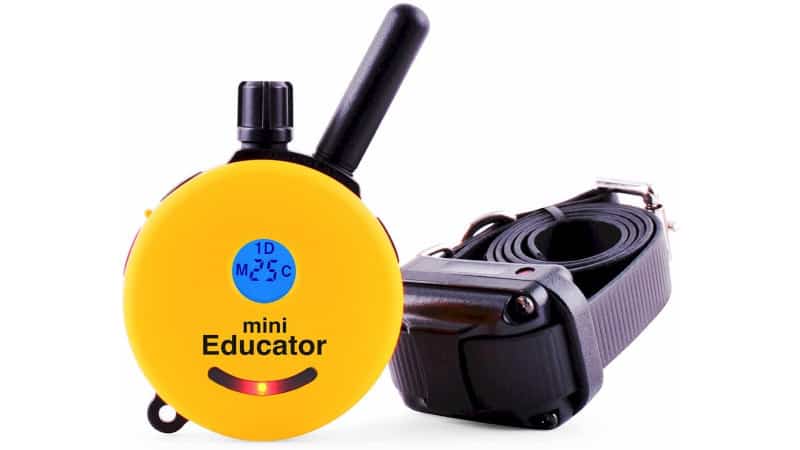
Got a small dog and want a training collar that’s less stressful for them to put on? Look no further than the Educator E-Collar ET-300.
Instead of utilizing a jolt or sharp static correction to modify your dog’s behavior, it delivers a tapping sensation similar to vibration but is more intense. Plus, the blunt stimulus provided doesn’t have the head jerking motion that other training e-collars are known for, making it relatively comfortable and less stressful for dogs to wear yet is as effective.
Additionally, it has user-selectable stimulation levels from 1 to 100 in either nick or continuous mode, with additional boost stimulus adjustable from 1 to 60. It also features Pavlovian Tone, in which your pup will hear a tone followed by stimulation. The purpose of that is to help them learn to respond to the sound itself rather than the stimulus.
The dog training collar is impact-resistant, waterproof, and can cover up to a range of 880 yards. We also like that it has an intuitive lock and set option to prevent accidental over-stimulation. And the stopwatch-style controller also allows you to either flash or continuously light up the collar receiver for locating your furkid after dark.
Features:
- Blunt stimulation technology
- Available in either ½- or ¾-mile range
- 100 correction levels
- Momentary or continuous mode
- Boost level from 1 to 60
- Pavlovian Tone
- Two sets of contact points
- Lock and set feature
- Tracking light
- Waterproof
- Shock-resistant
- Lithium-polymer rechargeable batteries
- Ideal for dogs weighing 5 pounds and larger
- It delivers a blunt stimulus that can effectively improve behavior yet won’t be as stressful for the wearer to put on, making it an ideal option for small or timid pets
- The contact points are made of titanium without nickel, allowing canines to wear without experiencing redness and irritation, meaning it is also great for sensitive dogs
- The remote is compact, lightweight, and easy to hold
- It comes with a dual battery charger that allows you to charge both components simultaneously
- It is relatively hard to program and use at the start
Bottom Line: A gentle and humane dog training collar featuring a broad range of blunt stimulation levels that won’t jerk a dog’s head and make the dog stressed, making it perfect for small or timid canines.
4. Best for Stubborn Dogs - Dogtra 1900S Remote Training Collar
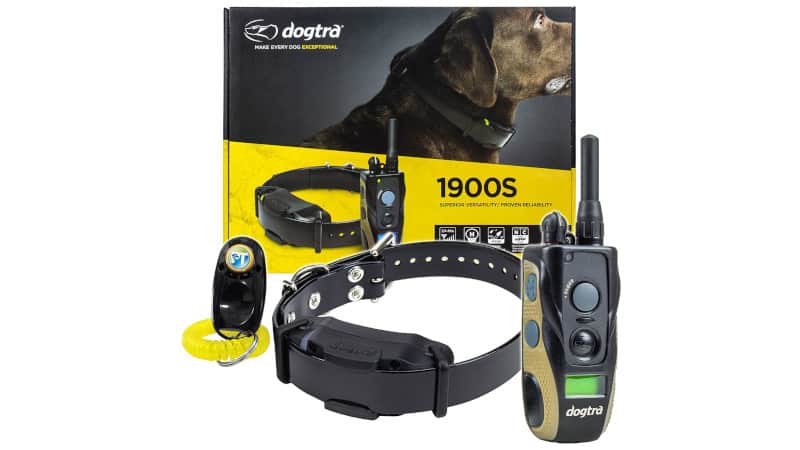
Training stubborn dogs can be a challenge. If your pup refuses to listen to you every time you try to correct their bad behavior, and it just won’t work no matter how hard you try, consider the Dogtra 1900S Remote Training Collar. It is designed to train dogs with mild to most stubborn temperaments.
It is fully waterproof, ergonomically shaped to a dog’s neck, and has an impressive range of up to ¾ mile (1320 yards), allowing your pup to roam free in an open field while remaining in charge. Completed with 127 correction levels, ranging from low to high, momentary or nick, constant, and high power pager vibration only modes to effectively get your bullheaded dog to comply.
The training levels will appear over an LCD screen on the handheld unit and is adjustable with the rheostat dial. Plus, it will also show you the battery status.
Features:
- Three training modes
- ¾ -mile range
- 127 correction levels
- Rheostat dial
- LCD screen
- IPX9K waterproof certified
- Ergonomic slim receiver
- Enhanced contact points
- 2-hour rapid charge batteries
- Recommended for dogs weighing at least 35 pounds
- Include a dog training clicker
- It is powerful enough to get most stubborn dogs to listen
- It is fully waterproof and incredibly durable
- One of the top choices among serious amateurs and award-winning professional dog trainers in pet obedience, hunting, and competition trials
- Only suitable for 35 pounds or heavier pets
- Lack of tone mode
Bottom Line: This dog training e-collar makes a great choice if you have a big, tough pet who refuses to obey. It has a high output and comes with nick and constant stimulation and high-performance pager vibration only modes, with a broad range of correction levels to let you match the intensity to your dog’s stubborn temperament.
5. Best for Budget - TBI Pro Dog Training Collar with Remote
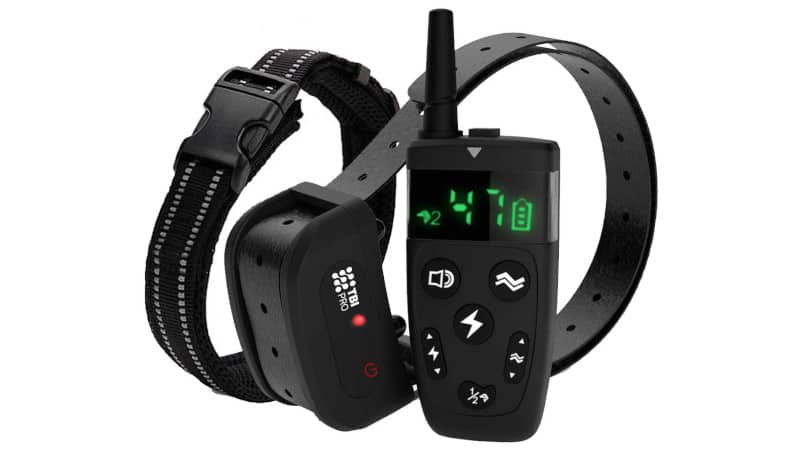
Priced under $50, the TBI Pro Dog Training Collar with Remote makes an excellent option if you are on a tight budget.
It has a range of up to 1,600 feet and features three safe training modes, beep, vibration, and shock, to teach your dog to stop behaving the way you don’t want them to. The intensity level is adjustable from 1 to 100, and you can deliver static shock or vibration continuously for 10 seconds max.
The receiver collar is waterproof and rated at IP67, meaning it will still work even when immersed in water, allowing your pooch to walk safely with the collar on while raining or playing by the pool. Not only that, but it also has overvoltage protection that will shut the output when the voltage exceeds a pre-set level to prevent any damages to the components.
Additionally, this shock collar allows you to control up to two dogs at a time and has a lithium-ion battery that can last up to 15 to 20 days after two to three hours of charge.
Features:
- Three training modes
- Range up to 1,600 feet
- Waterproof receiver
- Li-ion rechargeable battery
- Fit dogs weighing between 10 and 100 pounds
- It is very affordable compared to other brands yet has all the features you would want in a dog shock collar
- Easy to use
- Backed by a one-year replacement guarantee
- One complaint most pet parents have is that it will go into a sleep mode and won’t come back on unless you press the power button on the collar, which can be frustrating, especially when your pup is away from you and starts misbehaving
Bottom Line: An affordable training solution for dog owners who are trying to save a few bucks.
Why Use a Dog Shock Training Collar

A shock collar for dogs, also known as an e-collar, training collar, or remote dog training collar, serves multiple purposes, from getting your dog’s attention to reinforcing commands your canine already knows and modifying unwanted behavioral issues. Below are the things you can achieve with these devices.
- Teach your dog to walk nicely on a leash.
Dog shock collars are like no-pull harnesses for dogs. These devices allow you to teach your canine to stop yanking the leash. When they begin pulling, tell them no and administer a shock with the remote, and they should stop that right away. Sooner or later, they will learn that they will get a static correction when they pull on the leash and eventually stop that behavior. - Stop your dog from jumping on people.
Have you ever encountered a situation where your dog suddenly jumps on people to greet them? As much as you know your pooch is trying to be friendly, not everyone will appreciate that. Whether it is them jumping on strangers in the park, neighbors, or visitors that come over to your place, a shock collar can help eliminate that behavior. - Stop incessant barking.
Sure, it is natural for dogs to bark. But not everyone can tolerate excessive barking, especially your neighbors who might come over and knock on your door to complain about your dog. Much like an ultrasonic dog bark control device and a bark collar, a dog training collar can put incessant barking to an end. - Prevent destructive chewing.
Destructive chewing such as destroying carpets and your furniture is not only costly but also harmful for your furry friend as they may potentially swallow the pieces of the objects they bite and become lodged in their intestine. Using an e-collar can help deter, prevent, and correct that unwanted behavior. - Teach your dog about outdoor safety.
You can also use an electric shock collar to teach your dog not to go close to foreign objects or animals that will potentially injure them. Say if you want to train them to stay away from rattlesnakes, you can leave a toy snake on the ground and deliver a static shock to them when they walk close to it. Eventually, your pooch will associate the shock with rattlesnakes and will avoid this venomous animal when they encounter one. - Manage aggressive behavior.
Shock collars can also help manage dogs’ aggression, especially food aggression and aggression towards people and other dogs. However, this may only be able to solve the issue temporarily. Also, it is crucial to note that shock collars are not suitable for fear aggressive dogs as this will only frighten them and aggravate the problem. - Train multiple dogs at a time.
For an electronic collar to work, you will, of course, need a handheld unit. And most brands have a remote that can pair with a few more shock collars. In other words, you can train multiple dogs simultaneously. - Teach your dog to hunt.
A training collar can also come in handy, especially when teaching hunting dogs to retrieve in the field, although some hunters may prefer using a dog training whistle. With the collar’s tone or vibrate function, you will be able to teach, communicate, and command your gundog to perform a specific task at a distance. - Contain your canine. You can also use a dog shock collar as a perimeter tool to prevent your pup from roaming near the main roads or wandering onto your neighbors’ property. That said, there are far better containment systems like wireless fences or underground fences, which will automatically warn and deliver a stimulus to your fido when they try to leave a defined area.
Best Dog Training Collars Buyer’s Guide : Things to Consider
With so many different electronic dog collars available on the market, it can be hard to choose the best one for your four-legged friend. To help you make an informed decision, we’ve listed some of the features that may make one better than the other.
1. Type of Shock Collar for Dogs
If you’ve been shopping for a dog shock collar, you notice there are three fundamental types. They are training collars, anti-bark collars, and invisible fence collars.
Training Collars
Training collars are what we have recommended in this article. These devices come with a remote control that typically allows you to transmit three different types of signals to your furkid, including audible, vibrations, or shock, explicitly designed to let you train your dog or correct their unwanted behavior.
Anti-bark Collars
Like a spray collar or vibration collar, anti-bark collars are gadgets specifically made to deal with excessive barkers. Rather than manually administering a correction when your dog barks, this type of collar has an in-built smart chip or sensor that will trigger it when it detects your dog’s unique barking style and vocal cord movement. That also means your pup will receive electric pulses straight away when they bark without needing you to do anything, which is a far more effective tool for stopping incessant barking.
Invisible Fence Collars
On the other hand, invisible fence collars are containment systems designed to keep your four-footed friend safe inside a set perimeter. These collars come in two types. One is wireless, while another one will require you to bury included wire underground. Both allow you to define a safe space, and whenever your dog walks close to the boundary, the transmitter will send signals to the receiver collar to warn your pooch. If they proceed to cross the edge, it will transmit a static shock to your dog.
2. Multiple Correction Modes
You notice some training collars only have shock stimulation, while some will also allow you to trigger tone and vibration. Choosing the latter may be a better idea as you will have the ability to train your pup with signaling modes that are less stressful to them. In fact, you should always use the beeps or vibration mode or the mildest static correction first and only increase the intensity if your dog doesn’t respond.
3. Adjustable Stimulation Levels
You wouldn’t want to use the same stimulation level on both Chihuahuas and German Shepherds. Likewise, a timid canine doesn’t need the same static correction level as a stubborn dog. So, it is crucial to choose an e-collar that allows you to customize its static shock power.
But obviously, not all training collars have the same range of intensity settings. For instance, the Dogtra 1900S Remote Training Collar has 127 levels, while the DOG CARE Dog Training Collar has 99. The more level it has, the better. The reason being is that you can fine-tune the intensity that works just right for your dog.
Not only that but picking a shock collar with more correction levels also means you can use it for an extended period as you can increase the intensity of the stimulus when your pooch has accustomed themselves to the current setting you use.
4. Range
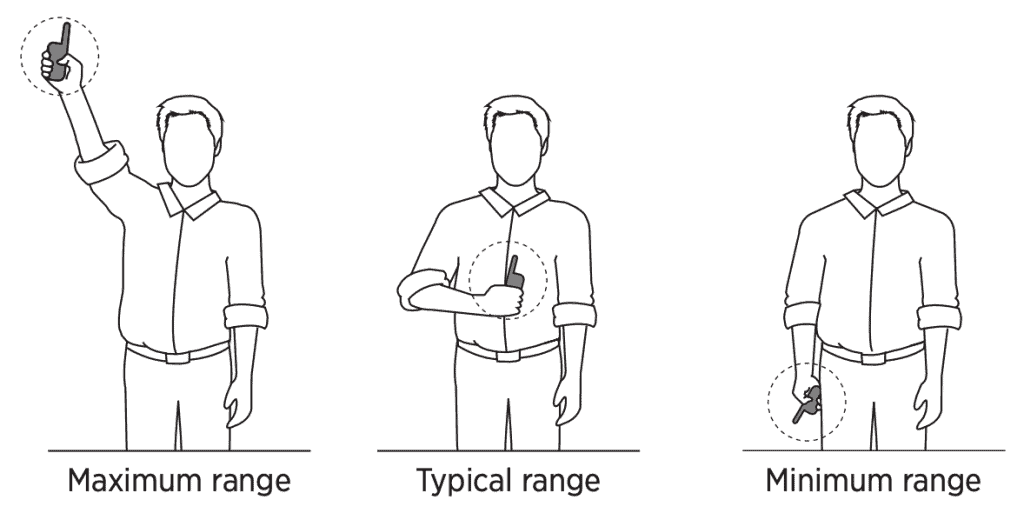
The next thing that you would want to check is the electric collar’s maximum effective range. Most shock collars have a 330-yard range, which will be sufficient in most cases, especially if you will only use the device at home or around the neighborhood. But if you need it for off-leash training or teaching your hound to hunt in the field, you would be better off picking the ones that can cover a greater distance, like the Dogtra 1900S Remote Training Collar.
Need help with converting the unit of length?
- ¼ mile = 440 yards = 1,320 feet
- ½ mile = 880 yards = 2,640 feet
- ¾ mile = 1,320 yards = 3,960 feet
- 1 mile = 1,760 yards = 5,280 feet
5. Waterproof
Also, it’s best to select a dog shock training collar that is waterproof. That way, you don’t have to be forced to take it off your dog when it rains or if your pup wants to go for walks along a river or play in puddles. And if you are a waterfowl hunter who needs your gundog to trek through the water to retrieve game, you will most certainly need a fully waterproof model like the SportDOG Brand 425X.
6. On-Off Buttons
The buttons on the remote of most training collars are pretty easy to press, meaning you can accidentally deliver a static shock when you don’t intend to, which is especially true if you carry the transmitter in your pocket. So, it’s a good idea to consider the ones with a lock and unlock setting like the DOG CARE Dog Training Collar and Educator E-Collar ET-300, although this feature is rare in electric collars.
7. Transmitter Size, Display, and Controls
- Size.
We prefer a smaller and compact size transmitter as we can easily slip it in our pocket and only take it out when needed. But people with larger hands may prefer a larger remote as it will be easier for them to hold. - Display.
Not all transmitters have a screen, but if the one you choose has one, you want to make sure it is easy to read, even in dim light conditions. There are two types of displays you will find, which are LEDs and LCDs. The only advantage of LCDs is that they come at a lower price point. While collar remotes that use LEDs are relatively expensive, they have a better quality image and are more energy-efficient, which is a better choice if you are also the kind of person who doesn’t want to keep charging it. - Controls.
All remotes have different controls, and the main ones are rheostat dials, click dials, and buttons. Rheostat dials are smoother and easier to turn but may be hard to hit a specific correction level you want. In contrast, click dials have tension between each intensity setting, in which when you turn the dial, it will click into the exact level you desire. Buttons, on the other hand, are the easiest to operate. However, you will need to check on the screen to see what level you are on, which some people may not like.
8. Support Multiple Collars
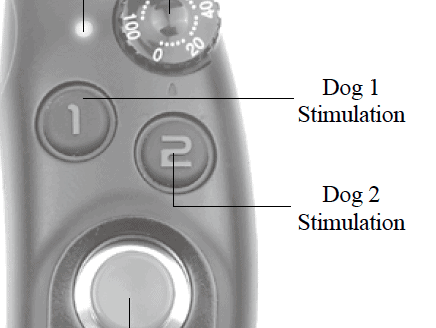
Do you have multiple dogs at home? If so, choosing a training system that can pair with more than just one shock collar may be a wiser choice. Fortunately, most units on the market today can support up to two or three receiver collars, and some like the DOG CARE Dog Training Collar even allow you to control up to a whopping nine dogs at a time!
9. Rechargeable Batteries
Just think about how inconvenient it will be if you have to keep buying new batteries when the unit stops working. Don’t want that hassle? Make sure to choose the ones that are rechargeable batteries powered.
Advantages of a Dog Shock Collar
1. Correct Bad Behavior on the Spot
One of the advantages of shock collars is that they allow you to correct your dog’s unwanted behavior on the spot. For instance, if you caught your furkid chewing your furniture, you can immediately emit a correction instead of, say, 15 minutes later, which by then, won’t be effective anymore.
2. Fast Results
Most pet owners claimed that shock collars could help them correct their dog’s bad behavior in a short period, and some even said it only took just a few administrations of electric pulses to get their dogs to comply. However, it all depends on your dog’s temperament. If you have a stubborn dog, it may take you a bit longer to train them.
3. Affordable
Hiring a professional dog trainer can cost a small fortune, which you will expect to pay for about $125 to $400 an hour for private training, depending on where you live. But most dog shock collars are available under $200, and even the high-quality ones only cost between $200 and $500. Plus, the cost of a shock collar is just one-off, whereas if you hire a dog trainer, the training fee is recurring.
Disadvantages of a Shock Collar for Training
1. Negative Reinforcement
Shock collars are a controversial training tool as they rely on negative reinforcement, in which these devices deliver an aversive stimulus to your dog and make them uncomfortable. And as a result of that, your pup would, in the future, avoid engaging in an unacceptable action to prevent receiving negative consequences. Many dog owners are against this type of training method as they are afraid that it may do more harm than good.
That said, many professional trainers and those who favor remote training collars don’t agree. They argue that shock collars don’t always mean negative reinforcement or “painful” shocks, adding that it ultimately depends on how the pet parent uses the collar and if they have adjusted the settings correctly. Also, they believe that if used properly and combined with positive reinforcement training and that you introduce remote collars to your dog in a positive way, they are a very effective tool.
2. Can Potentially Hurt Your Dog Physically and Mentally if Misused
If misused, shock collars can hurt your dog. Over time, your dog may develop fear and anxiety as they are scared they will get penalized for doing something deemed inappropriate. In fact, a study has shown that aversive training methods may jeopardize a dog’s mental health.
Guide on How to Safely Train Your Dog with a Shock Collar with Remote

1. Start with the Mildest Correction Possible
Since dog training collars deliver electric current to your dog when triggered, you would want to start training your furkid with the lowest correction setting possible to prevent hurting them. And only progress to the next level if your dog isn’t responding to it.
2. Avoid Over-Correction
Yes, it can be frustrating when your pup doesn’t want to comply, and you may be tempted to amp up the intensity, say from 10 to 80, hoping to get them to listen and understand quicker. But don’t do that. Overdoing it will not only scare and harm your dog but will potentially lead to more serious behavioral problems down the line.
3. Show Your Dog the Good Behavior You Want
It can get too overwhelming for your canine if they keep getting shocked, not knowing what they’ve done wrong and what they should do instead. So, you would need to show your pooch the behavior you want.
For instance, if you want them to stop digging in the yard, administer a shock to them and reinforce with a verbal command when they dig to let them know that that’s wrong. When they stop doing that, praise them and reward them with treats.
4. Pay Close Attention to Your Dog’s Behavior
You would also have to be observant and pay close attention to your fido’s behavior. No one wants and likes to be punished after all. When you notice they are agitated, make sure to lower the intensity level.
Best Dog Shock Collar FAQ
1. Will electronic collars or e-collars hurt my dog?
Perhaps the most common question people would ask is that will dog training collars hurt their dogs. Shock collars used to be an aversive training tool designed to punish dogs but have changed in recent years. Though the purpose is still to train or curb unwanted behaviors, they don’t mean to hurt your dog, but rather to cause them enough discomfort to get their attention and stop what they are doing.
That said, if you set the static level to the highest, it will, of course, hurt your dog, which is why it is vital to use either the tone or vibration function first. And if you need to use the static correction, always follow the manufacturer’s instructions and start with the lowest setting, then only tune it to a higher stimulation level if necessary.
It is important to note that you should never use an e-collar to punish your dog, but more of getting them to associate the unpleasant feeling with bad habits so that your pup doesn’t repeat acting in a certain way you don’t want them to next time.
2. Are shock collars for dogs safe?
Yes and no. Yes, it is safe if you only use tone and vibration training mode. And no. It is not safe if you use static stimulation as it can potentially burn your canine’s skin, especially if you administer the highest level of shock to your dog.
3. Should I use a remote dog shock collar?
It really is up to you whether or not to use a remote dog shock collar as there are several pros and cons. If you think it will help train your dog, then go for it. Just make sure to use it properly and not abuse it, or else it could do more harm than good. If you’re not comfortable with the idea of using a shock collar, there are many other training methods you can try. You don’t necessarily need to use one just because someone else has had success with it. Do what you think is best for you and your dog.
4. Do vets recommend shock collars?
No. Most vets will advise against the use of electronic training collars. And well, to be fair, if you put yourself in their shoes, seeing traumatized or injured dogs in your clinic as a result of e-collars would definitely make you think that these devices are bad.
But have you ever thought about the possibility that the misuse of these devices is what leads to all bad results and not the collars themselves? And with no disrespect, vets are not experts in dog training, so their opinion should be taken as what it is: an opinion.
At the end of the day, it’s your call to make. Again, don’t use one if you’re not comfortable with these tools. But just remember that if you opt for a shock training collar for dogs, you must educate yourself on how to use it properly.




